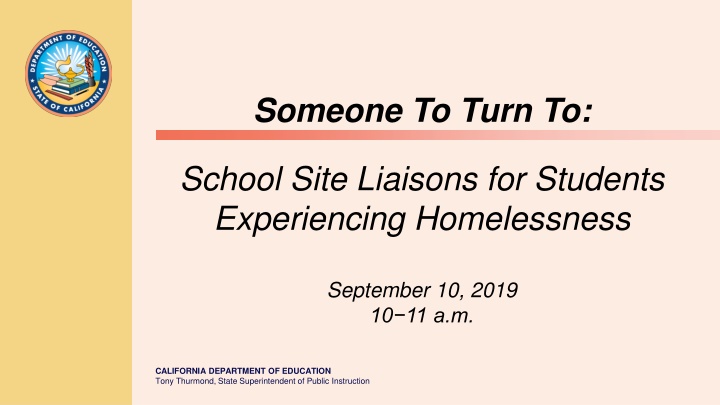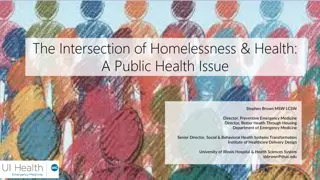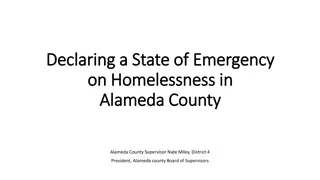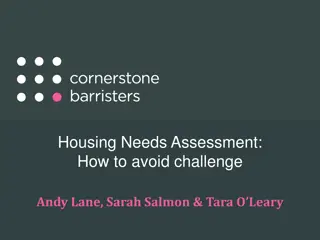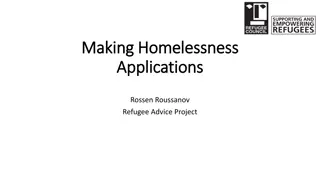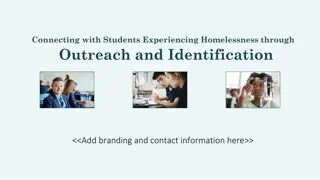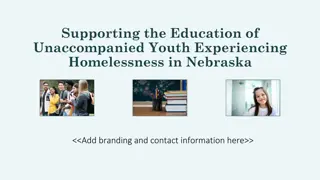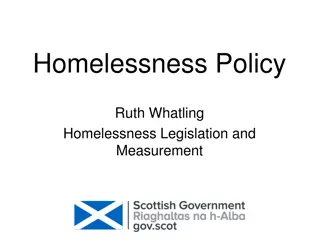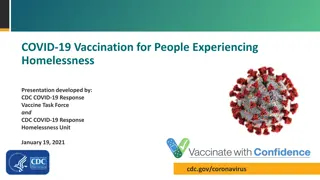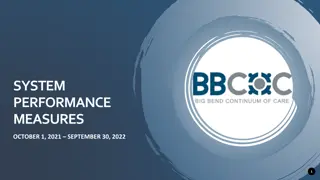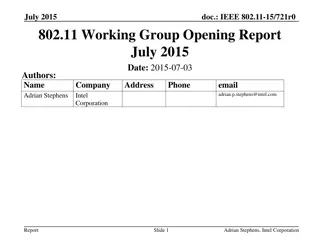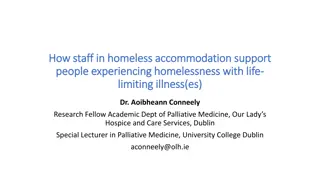School Site Liaisons for Students Experiencing Homelessness - Ensuring Equal Access to Education
The McKinney-Vento Act of 1987 mandates that local educational agencies appoint liaisons to support homeless students and ensure they receive adequate education. These liaisons play a crucial role in navigating the school system and upholding the Act's principles for equal access to education.
Download Presentation

Please find below an Image/Link to download the presentation.
The content on the website is provided AS IS for your information and personal use only. It may not be sold, licensed, or shared on other websites without obtaining consent from the author.If you encounter any issues during the download, it is possible that the publisher has removed the file from their server.
You are allowed to download the files provided on this website for personal or commercial use, subject to the condition that they are used lawfully. All files are the property of their respective owners.
The content on the website is provided AS IS for your information and personal use only. It may not be sold, licensed, or shared on other websites without obtaining consent from the author.
E N D
Presentation Transcript
Someone To Turn To: School Site Liaisons for Students Experiencing Homelessness September 10, 2019 10 11 a.m. CALIFORNIA DEPARTMENT OF EDUCATION Tony Thurmond, State Superintendent of Public Instruction
Agenda 1. Introductions 2. Background 3. Designating School Site Liaisons 4. District Spotlights 5. Closing TONY THURMOND State Superintendent of Public Instruction 2
Facilitators TONY THURMOND State Superintendent of Public Instruction Alexis Piazza, American Civil Liberties Union (ACLU) Foundation of Southern California Patricia Julianelle SchoolHouse Connection Leanne Wheeler, California Department of Education 3
The McKinney-Vento Act (1 of 2) The McKinney-Vento Homeless Assistance Act (McKinney- Vento) was enacted in 1987 to ensure that children and youth experiencing homelessness have access to the same free, appropriate public education as their non-homeless peers. TONY THURMOND State Superintendent of Public Instruction 4
The McKinney-Vento Act (2 of 2) The law applies to all local educational agencies (LEAs), irrespective of whether the LEA receives funding under the federal program. California defines LEA broadly to include a school district, county office of education, charter school, or special education local plan area. TONY THURMOND State Superintendent of Public Instruction 5
LEA Homeless Liaisons (1 of 2) McKinney-Vento requires all LEAs to designate an appropriate staff person as a local homeless education liaison (LEA liaison). LEA liaisons play a critical role in ensuring compliance with McKinney-Vento, helping families navigate the school system, and furthering McKinney-Vento s goal of ensuring equal access to a free, appropriate public education. TONY THURMOND State Superintendent of Public Instruction 6
LEA Homeless Liaisons (2 of 2) McKinney-Vento requires that LEA liaisons be able to carry out the duties described in the law. California Homeless Youth Project/ACLU Survey: 66 percent of LEA liaisons spend zero to five hours per week on McKinney-Vento duties. TONY THURMOND State Superintendent of Public Instruction 7
LEA Homeless Liaison Duties (1 of 4) Under McKinney-Vento, LEA liaisons shall ensure that: 1. Students experiencing homelessness are identified by school personnel; 2. Students experiencing homelessness are enrolled in school and have a full and equal opportunity to succeed; 3. Students experiencing homelessness receive educational services for which they are eligible, including Head Start; TONY THURMOND State Superintendent of Public Instruction 8
LEA Homeless Liaison Duties (2 of 4) 4. Students experiencing homelessness and their families receive referrals to appropriate services, including health care services, dental services, mental health and substance abuse services, and housing services; 5. Parents or guardians are informed of their children s educational opportunities and have meaningful opportunities to participate in their children s education; TONY THURMOND State Superintendent of Public Instruction 9
LEA Homeless Liaison Duties (3 of 4) 6. Public notice of the educational rights of students experiencing homelessness is disseminated; 7. Disputes over eligibility, school selection, or enrollment are mediated; 8. Parents or guardians of students experiencing homelessness are informed of all available transportation services and assisted in accessing transportation to school; TONY THURMOND State Superintendent of Public Instruction 10
LEA Homeless Liaison Duties (4 of 4) 9. School personnel providing services to students experiencing homelessness receive professional development and other support; and 10.Unaccompanied homeless youth receive additional help, such as verifying their independent status for the Free Application for Federal Student Aid, commonly referred to as FAFSA. TONY THURMOND State Superintendent of Public Instruction 11
School Site Homeless Liaisons (1 of 3) Given the LEA liaison s numerous and crucial responsibilities, many LEAs find it necessary to designate a staff person at each school site to help identify and assist students experiencing homelessness (school site liaisons). School site liaisons help ensure that liaisons are able to carry out the duties described in the law, by providing support at each school building. TONY THURMOND State Superintendent of Public Instruction 12
School Site Homeless Liaisons (2 of 3) The National Center for Homeless Education recommends school site liaisons, as they help ensure school-level staff understand the needs of homeless students and their rights under the McKinney-Vento Act and enable them to work more effectively with the students. TONY THURMOND State Superintendent of Public Instruction 13
School Site Homeless Liaisons (3 of 3) California Homeless Youth Project/ACLU Survey: Based on statewide survey of over 500 LEA liaisons, 84 percent reported implementing school site liaisons across their LEA. TONY THURMOND State Superintendent of Public Instruction 14
Whom to Designate (1 of 3) Under United States Department of Education guidance, LEA administrators should : 1. Allocate sufficient time for liaisons to do their jobs effectively; 2. Support liaisons in fulfilling their duties and in making timely decisions; 3. Review the legal requirements for the position; 4. Review data indicating the prevalence and needs of homeless children in the LEA; TONY THURMOND State Superintendent of Public Instruction 15
Whom to Designate (2 of 3) 5. Review past technical assistance provided to the LEA; 6. Consider the number of schools and students in the district, the number of identified homeless students as a percentage of students living in poverty, and any recent monitoring findings; and, 7. Discuss the time allocation with others. TONY THURMOND State Superintendent of Public Instruction 16
Whom to Designate (3 of 3) California Homeless Youth Project/ACLU Survey: LEAs in California regularly designate administrators, counselors, or clerical staff as school site liaisons. Some LEAs even designate two liaisons at each site one administrator and one front office personnel to handle training and identification, respectively. TONY THURMOND State Superintendent of Public Instruction 17
Whom NOT to Designate LEAs should not designate School Resource Officers (SROs) or other law enforcement personnel as school site liaisons. Research has found that the presence of SROs has led to high rates of citations/arrests among students of color and students with disabilities. Many families feel stigma around their housing status and have concerns about sharing their information with law enforcement. TONY THURMOND State Superintendent of Public Instruction 18
LEA/School Site Liaison Protocol (1 of 2) LEAs should establish a protocol for how the school site liaisons work with the LEA liaison: School site liaisons may be better-suited for some duties, such as identification, enrollment, and referrals to outside services LEA liaisons may be better-suited to lead on other duties, such as transportation, dispute resolution, and trainings. TONY THURMOND State Superintendent of Public Instruction 19
LEA/School Site Liaison Protocol (2 of 2) For a sample protocol, see the CDE Guidance Appendix A. The LEA liaison has the ultimate responsibility to ensure that the duties under McKinney-Vento are carried out. TONY THURMOND State Superintendent of Public Instruction 20
Whom to Inform LEAs should inform the state coordinator of the LEA liaison s name and contact information and contact the State Coordinator every time there is turnover. LEAs should inform school personnel, service providers, advocates, parents, and students of the name and contact information of the LEA liaison and school site liaisons, as well as their respective duties. TONY THURMOND State Superintendent of Public Instruction 21
Spotlight: Oxnard Union (1 of 2) TONY THURMOND State Superintendent of Public Instruction Ray Gonzales Coordinator of Student Interventions Oxnard Union High School District (OUHSD) 22
Spotlight: Oxnard Union (2 of 2) 1. Background about OUHSD/my role 2. How OUHSD uses school site liaisons 3. How OUHSD selects, trains, funds liaisons 4. OUHSD s results 5. Recommendations TONY THURMOND State Superintendent of Public Instruction 23
Questions? TONY THURMOND State Superintendent of Public Instruction 24
Contact Information TONY THURMOND State Superintendent of Public Instruction Leanne Wheeler, California Department of Education Alexis Piazza, ACLU Foundation of Southern California Patricia Julianelle SchoolHouse Connection patricia@schoolhouse connection.org 202-905-6690 Lwheeler@cde.ca.gov 916-319-0383 APiazza@aclusocal.org 213-977-5225 25
